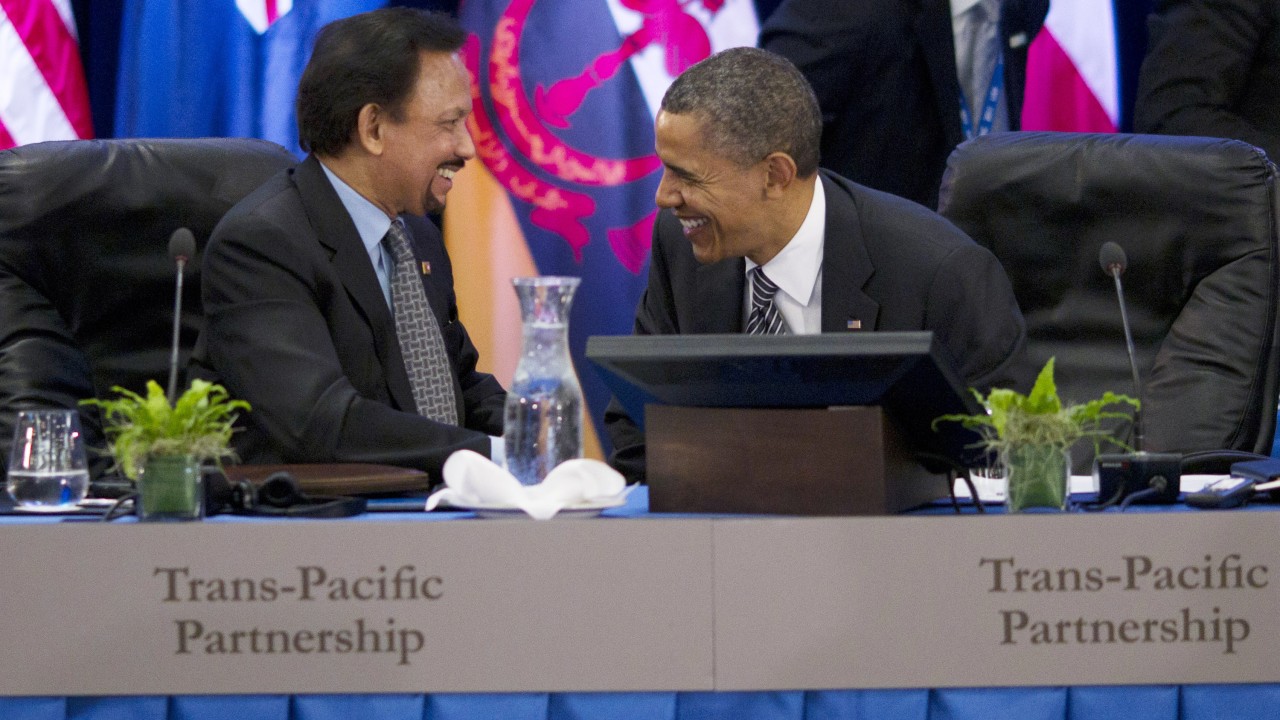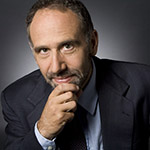
US President Barack Obama (R) speaks with Hassanal Bolkiah, the Sultan of Brunei after meeting with Trans-Pacific Partnership leaders during the APEC CEO Summit in Honolulu, Hawaii, November 12, 2011. (Photo by Kent Nishimura-Pool/Getty Images)
This post originally appeared at TruthOut.
Lately the media have been going wild mocking Donald Trump’s plans to put 45 percent tariffs on imports from China. They are partly right. It’s not clever to indiscriminately impose large tariffs on major trading partners in violation of existing trade agreements.
On the other hand, the projections of economic collapse are almost certainly way overblown. Furthermore, it would be reasonable to negotiate a lower value of the dollar against other currencies in order to reduce our trade deficit, even if the threat of big tariffs might not be the best way of getting there.
But what is even more striking is the selective concern over tariffs. While Trump wants to put large tariffs on imports from some of our major trading partners, President Obama is actively pushing to have far larger tariffs imposed on a wide range of goods in his trade deals, most importantly the Trans-Pacific Partnership (TPP). Measures in the TPP pushed by US negotiators will raise the price of many items by several thousand percent above the free market price.
If you missed this discussion, it’s because these trade barriers are referred to as “intellectual property,” which takes the form of patent and copyright protection. But markets don’t care what term politicians use to describe a government-imposed barrier. If a patent monopoly raises the price of a protected drug by 10,000 percent, it leads to the same sort of waste and corruption as if the government imposed a tariff of 10,000 percent, except that in the case of prescription drugs, high prices can also threaten lives.
If a price increase of 10,000 percent sounds high, you haven’t been paying attention to what the drug industry charges for its new drugs. For example, the list price for the Hepatitis C drug Sovaldi is $84,000 for a three-month course of treatment. A recent analysis found that Indian manufacturers can profitably produce the drug for just $200 per three-month course of treatment, suggesting a tariff equivalent of more than 40,000 percent.
And we have ample evidence that patent monopolies produce the same sort of distortions that trade theory predicts from extraordinarily high tariffs. First, we have a whole army of lobbyists who descend on government officials constantly pushing for stronger and longer patent protections. The industry employs a fleet of highly paid lawyers who attempt to intimidate generic competitors from entering a market, even if legitimate claims to protection have already expired.
The industry employs a massive number of sales representatives to push their drugs to doctors. And, we are treated to silly television ads that try to get patients to pressure doctors into prescribing drugs even when there is no reason to think they would help them.
And of course there is the enormous waste associated with dealing with high priced drugs. Patent protected prices cause us to have insurance companies that must decide on complex payment systems and the new industry of pharmacy benefit managers that negotiate directly with the drug companies for both insurance companies and hospitals. There would be no place for these intermediaries if drugs were selling at free market prices.
Then we get the bad stuff. Drug companies steer their research toward developing patentable products. Evidence that diet or environmental factors may be important in treating a condition is generally not pursued. Drug companies also routinely pay doctors to push their drugs for unapproved uses. And, they conceal evidence that their drugs may be less effective than claimed or potentially harmful.
It is also important to realize that this is not a minor sector of the economy. We spend more than $400 billion a year on prescription drugs (2.2 percent of GDP). We would likely spend close to one-tenth of this amount if drugs were available in a free market.
We all know the story about how we need patents to finance innovation, but this is nonsense as even some in the pharmaceutical industry are coming to recognize. There are plenty of other mechanisms of paying for research. For example, Andrew Witty, the CEO of GlaxoSmithKline, explicitly called for delinking the price of drugs from research costs. He proposed a system where the government pays for drug company research on a cost plus basis, with the drugs developed then sold as generics. We already support more than $30 billion a year in biomedical research through the National Institutes of Health.
So we do face a very real threat of protectionism, but it is in the form of the Obama administration pushing for stronger and longer patent and related protections in the TPP and other trade deals. Unfortunately most media outlets are perfectly happy with protectionism when the main beneficiaries are drug companies. It is only when someone proposes protectionist measures with the idea that they could help ordinary workers that they get upset.




